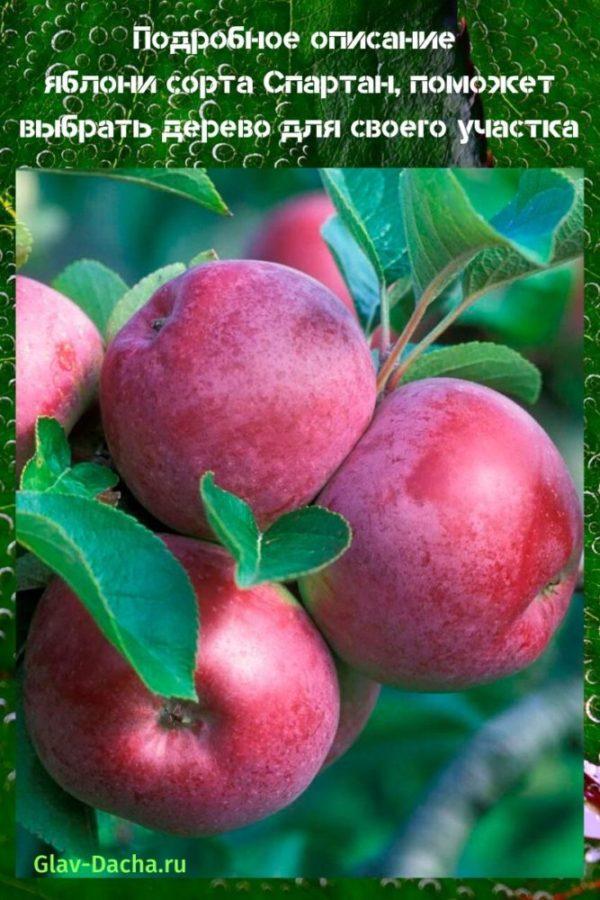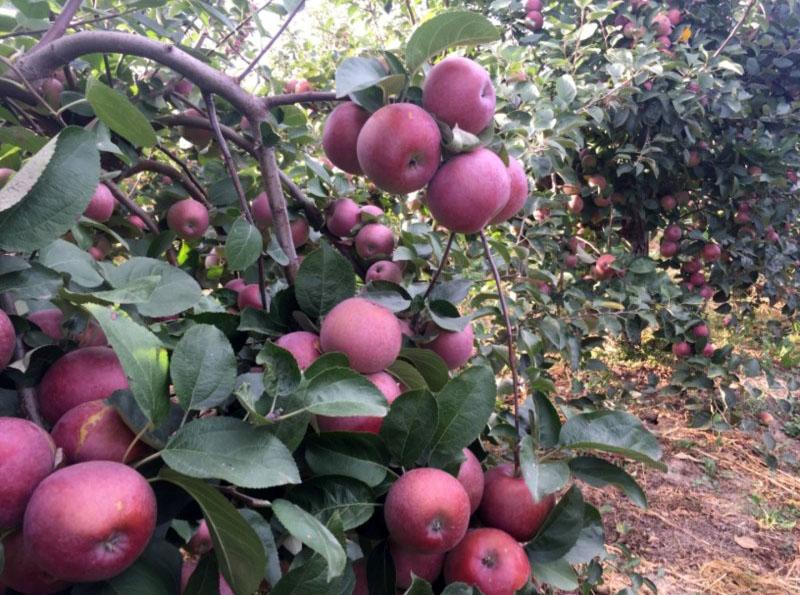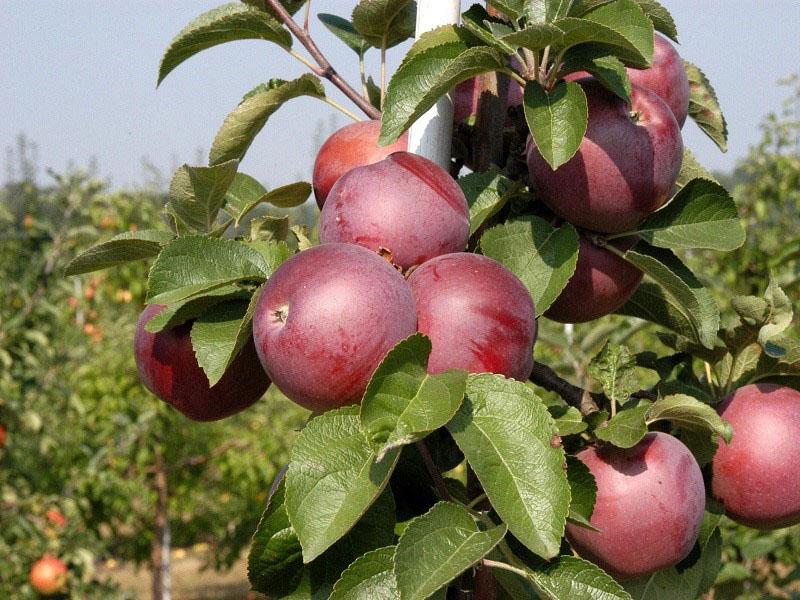A detailed description of the Spartan apple tree will help you choose a tree for your site
 The apple tree is the most popular culture, without which not a single summer cottage can do. Breeders are working on developing new varieties, improving existing plant species. The description of the Spartan apple tree informs us about the ability of the variety to break records in productivity, which is why the work of gardeners will not be in vain. Once you have planted an unpretentious seedling, you can enjoy juicy, sweet fruits for a long time, and also give a beautiful view to the garden.
The apple tree is the most popular culture, without which not a single summer cottage can do. Breeders are working on developing new varieties, improving existing plant species. The description of the Spartan apple tree informs us about the ability of the variety to break records in productivity, which is why the work of gardeners will not be in vain. Once you have planted an unpretentious seedling, you can enjoy juicy, sweet fruits for a long time, and also give a beautiful view to the garden.

A detailed description of the Spartan apple tree
 Apple tree Spartan has an individual dendrological characteristic and botanical features that should be considered when choosing this variety.
Apple tree Spartan has an individual dendrological characteristic and botanical features that should be considered when choosing this variety.
Characteristics of the fruit tree
 The height of the Spartan apple tree is 5–6 meters. The culture is medium-sized with a rounded, flattened crown. The many branches are placed at a 70-degree slope, which makes the tree look very lush. Shoots of medium thickness, dark cherry color, slightly pubescent.
The height of the Spartan apple tree is 5–6 meters. The culture is medium-sized with a rounded, flattened crown. The many branches are placed at a 70-degree slope, which makes the tree look very lush. Shoots of medium thickness, dark cherry color, slightly pubescent.
Shiny dark green leaves of a rounded shape have a raised glossy surface. They are small in size and have serrated edges.
Flowering begins in the month of May. The tree is covered with white flowers with a delicate and sophisticated scent.
Description of fruits and their taste

Attention is drawn to the fruits of the culture of dining purposes, which are characterized by:
- round or conical shape;
- firm violet-gray rind of medium thickness with a waxy bloom;
- juicy, tender white pulp;
- weighing from 90 to 120 g.
The taste of apples is sweet with a slight sourness and notes of melon, strawberry. The tasters rated it 4.5-5 points.
Pros and cons of the variety
 Describing the Spartan apple tree, it is important to outline its advantages and disadvantages.
Describing the Spartan apple tree, it is important to outline its advantages and disadvantages.
The demand and popularity of fruit crops among gardeners is due to a number of positive characteristics:
- high yield, from one tree you can get up to 100 kg of apples;
- early maturity - the plant forms the first harvest already in the third year after planting;
- annual fruiting;
- self-fertility;
- resistance to fungal, viral and bacterial diseases;
- excellent fruit taste;
- excellent transportability of the crop;
- the duration of storage of fruit without loss of taste, marketability;
- versatility in application, apples are good fresh and canned, used for making juices, drinks, in the production of confectionery.
The Spartan variety is not devoid of disadvantages:
- lack of resistance to cold and frost;
- the need for frequent shaping scraps.
The plant is afraid of even minor cold snaps, which is why it needs high-quality shelter for the winter.
Planting an apple tree Spartan
 The rules for planting and caring for the Spartan apple tree practically do not differ from standard requirements. But there are subtleties that you should know about in order to achieve high yields.
The rules for planting and caring for the Spartan apple tree practically do not differ from standard requirements. But there are subtleties that you should know about in order to achieve high yields.
Recommended timing
Plant apple seedlings of the Spartan variety in the spring at the end of April.During the summer months, young trees take root in the soil and acclimatize to external conditions. It is also allowed to plan planting in the fall in early October, a few weeks before frost. At the same time, it is important to carry out all measures to protect plants from strong temperature changes.
Selection of seedlings

Purchase planting material in specialized stores. When buying, pay attention to the following criteria:
- age should be no more than 1-2 years;
- lack of growth, diaper rash and damage to the root system and trunk;
- green tint of the shoot under the bark;
- the length of the roots is within 35-40 cm.
To ensure the integrity and suitability of the rhizomes, pull on them. If they are easily separated, then the seedling is unsuitable for planting due to rotting of the root system.
Choosing the right place
 The site should be spacious, well-lit, and also protected from strong winds and drafts. The variety is hygrophilous, therefore it is recommended to select places with a high occurrence of groundwater (1 meter).
The site should be spacious, well-lit, and also protected from strong winds and drafts. The variety is hygrophilous, therefore it is recommended to select places with a high occurrence of groundwater (1 meter).
The culture feels best on loosened chernozem, sandy loam soils. It is recommended to pre-enrich clay and hard soils peat, river sand.
Planting technology of seedlings

The seedling planting algorithm includes the following stages:
- Dig a hole 50 cm deep and 100 cm wide.
- Lay a drainage layer on the bottom using crushed stone.
- Cover with soil mixture with the addition of rotted manure, ash, potassium, superphosphate.
- Place the seedling in the hole, carefully distributing the root system and cover with nutritious soil, slightly shaking the trunk to fill the voids between the roots. In this case, the root collar should be 5 cm above the soil surface.
- Water abundantly and mulch.
When planting several seedlings, keep a distance of at least 3 meters between them.
How to care for a tree
Growing an apple tree requires compliance with agrotechnical rules. Any violation can lead to a decrease in yield, the appearance of diseases and an invasion of pests.
Watering
 The apple tree is very fond of moisture and does not tolerate drought. Watering frequency depends on climate and rainfall. Water young trees once a week, using 2-3 buckets of water, and trees aged 4-5 years, twice a month, using 40 liters of water.
The apple tree is very fond of moisture and does not tolerate drought. Watering frequency depends on climate and rainfall. Water young trees once a week, using 2-3 buckets of water, and trees aged 4-5 years, twice a month, using 40 liters of water.
Pay special attention to watering before bud break, in the phase of formation of the first ovaries and a few days before harvesting.
Top dressing

Throughout the season, it is recommended to enrich the soil with fertilizers based on minerals and organics:
- at the time of bud break, saturating the soil with humus and nitroammophos;
- in the phase of ovary formation, watering with manure or droppings infusion;
- during flowering, fed with a complex of fertilizers;
- as soon as the fruits begin to form, adding a solution of nitroammofoska and potassium;
- in preparation for winter, fertilizing with a mixture of superphosphate and potassium sulfide.
Late feeding will increase immunity and provide the culture with all nutrients during the rest period.
Mulching
 As a mulch, you can use cut grass, sawdust, straw. The procedure is necessary to improve air exchange, protect against erosion and rapid evaporation of moisture. Also, a layer of mulch will protect the soil from water erosion during irrigation and prevent weeds from developing.
As a mulch, you can use cut grass, sawdust, straw. The procedure is necessary to improve air exchange, protect against erosion and rapid evaporation of moisture. Also, a layer of mulch will protect the soil from water erosion during irrigation and prevent weeds from developing.
Pruning
 The first pruning is done after planting. The branches should be shortened by 1/3. In the future, so that the crown does not thicken, regularly cut off every spring, getting rid of weak, crooked, damaged shoots.
The first pruning is done after planting. The branches should be shortened by 1/3. In the future, so that the crown does not thicken, regularly cut off every spring, getting rid of weak, crooked, damaged shoots.
It is not recommended to remove lateral, regular-shaped branches, since the crown will be unstable.
Preparing for winter

The variety reacts poorly to cold weather, so it is important to provide it with high-quality shelter for the winter:
- A few weeks before the cold weather, loosen the soil, water abundantly, lay a layer of mulch from hay and straw.
- Do the last dressing this season.
- Wrap up the trunk with natural material: burlap, spruce branches.
As soon as the first snow falls, make a snowdrift around to protect the near-trunk zone from frost.
Diseases and pests
 Unfavorable climate conditions or neglect of the norms of agricultural technology lead to the occurrence of fruit rot, cytosporosis. In addition to diseases, the plant can attack the moth or flower beetle.
Unfavorable climate conditions or neglect of the norms of agricultural technology lead to the occurrence of fruit rot, cytosporosis. In addition to diseases, the plant can attack the moth or flower beetle.
Preventive measures that will help prevent the development of infections and the appearance of pests on the site:
- constant loosening of the soil;
- timely removal of weeds from the site;
- processing a plant with Bordeaux liquid;
- destruction of the remnants of autumn vegetation;
- control over the application of fertilizers and moisture.
When these activities are carried out, the plant will not be threatened, and a crop of high quality and quantity is ensured.
Harvesting and storage of crops
 Harvesting starts in the last days of September and lasts until October. Store the harvested fruits in wood or plastic boxes in a dry, well-ventilated, unlit room with a cool temperature.
Harvesting starts in the last days of September and lasts until October. Store the harvested fruits in wood or plastic boxes in a dry, well-ventilated, unlit room with a cool temperature.
The Spartan apple variety became famous due to its high yield rates, taste of the fruits. To succeed in growing a crop, you should study the planting rules in detail and provide the crop with proper care.